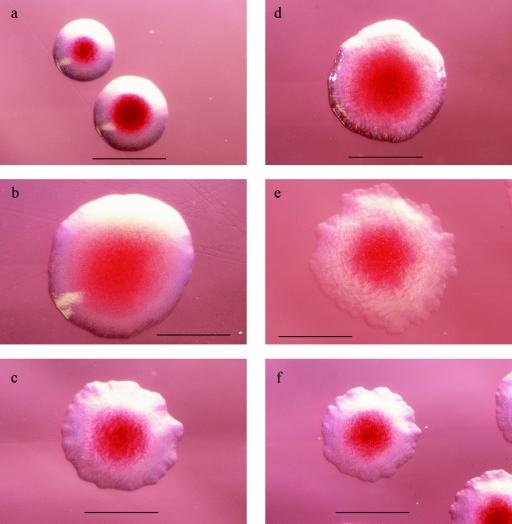FIG. 1.
Differentiating between Y. enterocolitica, Y. bercovieri, and Y. mollaretii on CIN agar (incubation at 30°C, 22 to 24 h) through a stereomicroscope (black bar, 1 mm). (a) Y. enterocolitica O:3 (pathogenic serotype, BT 4) appears as characteristically small (approximately <1 mm in diameter), circular colonies with entire edge. The colonies have a small, deep red center (bull's eye) with a sharp border surrounded by a translucent or transparent zone. (b) Y. enterocolitica BT 1A (nonpathogenic biotype). Large (approximately 2 mm in diameter), circular colonies with slightly lighter red center surrounded by a translucent to milk-white zone are shown. The center of the colony is large compared to the surrounding zone and has a blurred border. (c) Y. bercovieri. Erose-edged, slightly irregular circular colonies (approximately 1.5 mm in diameter) are shown, with a medium-red (sometimes pitting) center with an erose border. The surrounding translucent zone has a characteristic ground-glass appearance (best visible by slightly oblique illumination). (d and e) Y. mollaretii. Slightly irregular circular colonies (approximately 1.5 mm in diameter) are shown; a medium-red, diffuse center with no sharp borderline is visible. The surrounding translucent to milk-white zone has a characteristic ground-glass appearance (best visible in slightly oblique illumination). Two types exist: mucoid, with a smoother and more convex appearance (d) and a flat, dry, more irregular- and erose-edged colony (e). It has been noticed in EBL that approximately half of the incoming Y. mollaretii strains have a smooth, mucoid colony type and the other half have a dry, flat colony type (unpublished data). (f) Y. enterocolitica O:5,27 (pathogenic serotype). Circular, usually erose-edged (almost starlike) colonies (approximately 1 to 1.5 mm in diameter) are shown. A small, deep-red center with a slightly blurred border is visible. The surrounding translucent or transparent zone is large, compared to the center (as with Y. enterocolitica O:3), and has a ground-glass appearance.

